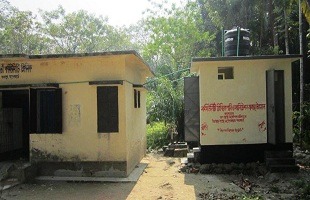In recent decades, Bangladesh has made a remarkable progress in health outcomes. In terms of providing primary health care, the country has achieved most of its health indicators showing the health status of the population is improved. Currently, number of steps have been taken by the government to improve its leadership and regulatory role to improve equity and quality of services, especially to reach the poor and the disadvantaged. Initiatives for development of new health policy, revitalization of primary health care by making all facilities functional with deployment of required human resource, supplies and logistics.
But, to sustain and keeping the success already achieved, ensuring safe water and sanitation facilities for patients are important. In general, lack of Water, Sanitation and Hygiene (WASH) provision in healthcare facilities also increasing the risk of healthcare acquired infections, and undermine national and global efforts to improve maternal, neonatal and child health. To increase in number of female patients in health facilities is possible while attributed to a cleaner and more comfortable environment ensuring their privacy. It is important to have the construction of gender-segregated latrines, installation of piped water systems and hand-washing devices. To make the system self-sustained a detail policy guideline on operation and maintenance of WASH facilities is energetic.
The public healthcare network of Bangladesh is a complicated web of public health departments, NGOs, and private institutions constitutes. Responsibilities and functions range from policy planning, regulation, implementation, and healthcare delivery to medical education. The Ministry of Health and Family Welfare (MOHFW) is responsible for formulating national-level policy, planning, and decision-making in the provision of healthcare and education. The healthcare infrastructure under the DGHS comprises six tiers: national, divisional, district, upazila (sub-district), union, and ward. The community clinics are the lowest-level static health facilities located at the ward level. These have upward referral linkages with health facilities located at the union and upazila levels.
There are 467 government hospitals at the upazila level and below, which altogether have 18,791 hospital beds. At the upazila level, there are 436 hospitals with 18,301 beds. At the union level, there are 31 hospitals with 490 beds and 1,362 health facilities for outpatient services only. So, at the union level, there are 1,393 health facilities. At the ward level, there are 13,036 community clinics in operation till date. But safe water supply, sanitation and hygiene provision at these facilities are still very much poor and there is gaps of available statistics to know the overall WASH situation in HCFs.
NGO Forum for Public Health is experienced more than three decades on this particular sector. The organization knows the situation better with understanding the issue. Due to the importance of Public Health concerns, NGO Forum has the mandate to initiate for facilitating and to act as a lead advocacy partner at policy level for bringing all sectoral stakeholders together. Such as MOH&FW, DGHS, DPHE, LGRD, LGED, Citiy Corporations, district and sub-district level HCFs management committees, development partners, private sectors, networks, alliances and communities to concentrate on the issue. And it is crucial of relevant policies, guidelines to review and create sensitization for developing an integrated operational guideline where WASH sector to be an integral part of operating Healthcare Facilities in Bangladesh.
The initiative of reconfirmation of establishing adequate WASH standards in healthcare facilities is an attainable goal which will ensure increasing utilization of Public Health Facilities.












